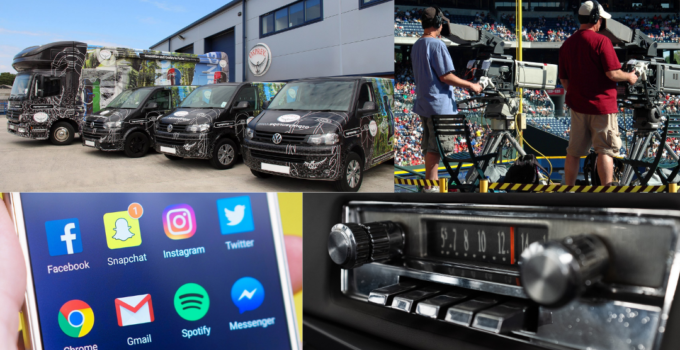In the ever-evolving landscape of marketing, where innovative strategies compete for attention, one approach has steadily rolled to the forefront: commercial vehicle marketing campaigns. These campaigns leverage the power of the road to showcase brands, products, and services to a vast and diverse audience. But with the abundance of marketing channels, how do you ensure your investment translates into tangible returns? The answer lies in understanding and measuring Return on Investment (ROI). In this comprehensive guide, we’ll explore the intricacies of commercial vehicle marketing, the influence of vehicle wraps, and the art of measuring ROI to ensure your campaign’s success.
Page Contents
1. Understanding Commercial Vehicle Marketing

Source: businesscoot.com
Commercial vehicle marketing is a strategic approach that involves transforming your company vehicles into moving billboards. This dynamic strategy is pivotal for amplifying brand visibility and expanding market reach. The components of a successful campaign go beyond a visually appealing vehicle wrap. Effective branding, a compelling message, and strategic placement are equally crucial. By tapping into this innovative channel, businesses can ensure their messages resonate with a broader and more diverse audience.
2. The Power of Vehicle Wraps in Marketing
At the heart of a successful commercial vehicle marketing campaign lies the vehicle wrap – a dynamic blend of art and advertising. These wraps turn ordinary vehicles into attention-grabbing mobile billboards, making your brand a captivating sight on the streets. A vividly designed vehicle wraps can tell a compelling story about your brand, forging a memorable impression on potential customers. Just think about the time you were stuck in traffic and couldn’t help but notice a creatively designed vehicle wrap. Such impressions are the currency of vehicle marketing.
3. Measuring ROI: The Basics
ROI is the compass that guides marketing decisions. It’s the ultimate measure of a campaign’s effectiveness. ROI represents the ratio of net profit to the cost of investment, expressed as a percentage. In the context of commercial vehicle marketing, ROI encapsulates both the financial returns and the broader impact on brand visibility and market share. This metric is crucial as it allows businesses to evaluate whether their investment is yielding the desired outcomes.
4. Factors Influencing ROI Measurement

Source: linkedin.com
Measuring ROI is not a one-size-fits-all endeavor. It’s influenced by a myriad of factors that can sway the results. Campaign duration, target audience demographics, and geographic reach all play pivotal roles in shaping the ROI outcome. A campaign targeting a densely populated urban area might yield different results compared to one in a rural setting. Recognizing these factors and tailoring your approach accordingly is essential for accurate ROI assessment.
5. Setting Clear Campaign Goals
Before embarking on any marketing campaign, it’s imperative to define clear and measurable goals. Are you aiming to boost website traffic, increase social media engagement, or drive foot traffic to your store? Well-defined goals serve as the foundation for ROI measurement. They provide a benchmark against which the campaign’s success can be assessed. When you know exactly what you’re aiming for, it’s easier to discern whether your ROI aligns with your objectives.
6. Tracking and Analyzing Campaign Costs
To determine ROI accurately, you must first understand the total investment. Commercial vehicle marketing campaigns encompass a range of costs – from designing and printing the wrap to installation and ongoing vehicle usage expenses. Each component contributes to the overall investment. Ensuring a comprehensive understanding of these expenses is crucial for a precise ROI calculation.
7. Evaluating Campaign Results

Source: aceresearchsystem.com
ROI measurement isn’t confined to financial metrics alone. Data-driven insights play a pivotal role. Tracking mechanisms like website visits, social media engagement, and customer inquiries provide a wealth of information about a campaign’s performance. Incorporating unique tracking tools such as QR codes or custom landing pages can offer deeper insights into consumer behavior and the impact of your campaign.
8. Quantifying ROI for Commercial Vehicle Marketing
Calculating ROI is a fundamental aspect of marketing accountability. The formula, though simple, is profound: (Net Profit / Cost of Investment) x 100. Here, the net profit signifies all revenue generated because of the marketing effort. In contrast, the cost of investment is a comprehensive figure that includes all campaign-related expenses, from advertisement creation to dissemination costs. By applying this formula, businesses can obtain a clear, numerical understanding of their campaign’s efficacy, illustrating the campaign’s financial success relative to the initial outlay.
9. Assessing Non-Monetary Gains
While many view ROI strictly in financial terms, it’s essential to recognize its broader scope. Tangible financial returns are just one piece of the puzzle. Equally crucial are intangible gains such as enhanced brand visibility, customer loyalty, and increased market share. These gains, though less straightforward, play a pivotal role in the long-term success of a business. While translating these intangibles into quantifiable metrics may appear daunting, methodologies like surveys, focus groups, and social media sentiment analysis can offer a lens through which to view them. Including these aspects in an ROI assessment paints a more comprehensive picture of the true impact of a campaign.
10. Comparative Analysis of ROI

Source: seekingalpha.com
Reviewing ROI in isolation has its merits, but juxtaposing it with data from other campaigns can be even more enlightening. By doing so, businesses can discern patterns, successful tactics, and areas of improvement. Such comparative analysis helps to identify which strategies have consistently delivered high returns and which have underperformed. By benchmarking different campaigns against one another, it becomes easier to determine the core elements contributing to success or failure. As marketers lean into this iterative feedback process, they can continually fine-tune their tactics, ensuring better ROI results with every subsequent campaign.
11. Making Data-Driven Decisions
A strategic marketer views ROI data as more than just numerical outcomes. Instead, they see it as a goldmine of insights, guiding the trajectory of future initiatives. By studying this data meticulously, businesses can extrapolate valuable lessons, informing decisions on budget allocation, audience targeting, and content creation. For example, if an analysis reveals that a campaign’s standout ROI stemmed from a unique design or a resonant message, those elements can be spotlighted and integrated more prominently in upcoming campaigns. Harnessing the power of this data ensures that every marketing decision is rooted in past successes, maximizing the potential for fruitful outcomes.
Conclusion
In the dynamic realm of marketing, where innovation is the norm, commercial vehicle marketing campaigns stand out as an effective and attention-grabbing strategy. But success isn’t merely about turning heads on the road; it’s about turning heads that matter into loyal customers. Measuring ROI ensures that your investment is yielding the desired results, both financially and in terms of brand visibility. By understanding the nuances of ROI calculation and embracing data-driven insights, businesses can navigate the winding road of marketing with confidence and propel their brands toward unparalleled success. So, gear up, wrap up, and set out on the path to marketing triumph!





